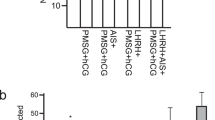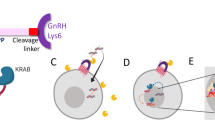Abstract
Production of foreign proteins in the tissues of transgenic animals represents an efficient and economical method of producing therapeutic and pharmaceutical proteins. In this study, we demonstrate that the mouse P12 gene promoter specific to the male accessory sex gland can be used to generate transgenic mice that express human growth hormone (hGH) in their seminal vesicle epithelium. The hGH is secreted into the ejaculated seminal fluids with the seminal vesicle lumen contents containing concentrations of up to 0.5 mg/ml. As semen is a body fluid that can be collected easily on a continuous basis, the production of transgenic animals expressing pharmaceutical proteins into their seminal fluid could prove to be a viable alternative to use of the mammary gland as a bioreactor.
This is a preview of subscription content, access via your institution
Access options
Subscribe to this journal
Receive 12 print issues and online access
$209.00 per year
only $17.42 per issue
Buy this article
- Purchase on Springer Link
- Instant access to full article PDF
Prices may be subject to local taxes which are calculated during checkout




Similar content being viewed by others
References
Jänne, J. et al. Transgenic bioreactors. Int. J. Biochem. 26, 859–870. (1994).
Eyestone, W.H. in Transgenic animals in agriculture (eds Murray, J.D., Anderson, G.B., Oberbauer, A.M. & McGloughlin, M.M.) 177–191 (University Press, New York; 1999).
Rosen, J.M., Li, S., Raught, B. & Hadsell, D. The mammary gland as a bioreactor: factors regulating the efficient expression of milk protein-based transgenes. Am. J. Clin. Nutr. 63, S627–S632 (1996).
Houdebine, L.M. The production of pharmaceutical proteins from the milk of transgenic animals. Reprod. Nutr. Dev. 35, 609–617 (1995).
Wall, R.J., Kerr, D.E. & Bondioli, K.R. Transgenic dairy cattle: genetic engineering on a large scale. J. Dairy Sci. 80, 2213–2224 (1997).
Swanson, M.E. et al. Production of functional hemoglobin in transgenic swine. Bio/Technology 10, 557–559 (1992).
Kerr, D.E., et al. The bladder as a bioreactor: urethelium production and secretion of growth hormone into urine. Nat. Biotechnol. 16, 75–79 (1998).
Anderson, L.L. in Reproduction in farm animals (ed. Hafez, E.S.E) 343–360 (Lea & Febiger, Philadelphia; 1993).
Setchell, B.P. & Brooks, D.E. in The physiology of reproduction (eds Knobil, E. & Neil, J) 753–836 (Raven Press Ltd, New York; 1988).
Fink, E. & Fritz, H. Proteinase Inhibitors from Guinea Pig Seminal Vesicles. Methods Enzymol. Vol. 45: 825–833 (1976).
Meloun, B., Cechovà, D. & Jonàkovà, V. Homologies in the structure of bull seminal plasma acrosin inhibitor and comparison with other homologous protease inhibitors of kazal type. Hoppe-Seyler's Z. Physiol. Chem. Vol. 364: 1665–1670 (1983).
Fritz, H., Tschesche, H. & Fink, E. Protease Inhibitators from Boar Seminal Plasma. Methods Enzymol. Vol 45: 834–847 (1976).
Tschesche, H., Wittig, B., Decker, G., Müller-Esterl, W. & Fritz, H.A. New acrosin inhibitor from boar spermatozoa. Eur. J. Biochem. 126, 99–104 (1982).
Huhtala, M.L. Demonstration of a new acrosin inhibitor in human seminal plasma. Hoppe-Seyler's Z. Physiol. Chem. 365, 819–825 (1984).
Cechovà, D. & Jonakovà, V. Bul Seminal Plasma Protease inhibitors. Methods Enzymology Vol. 80: 729–803 (1981).
Chen, L.Y., Lin, Y.H., Lai, M.L. & Chen, Y.H. Developmental profile of a caltrin-like protease inhibitor, P12, in the mouse seminal vesicle and characterization of its binding sites on the sperm surface. Biol. Reprod. 59, 1498–1505 (1998).
Mills, J.S., Needham, M. & Parker, M.G. Androgen regulated expression of a spermine binding protein in the mouse ventral prostate. Nucleic Acids Res. 15, 7709–7724 (1987).
Guérin, S.L., Pothier, F., Robidoux, S., Gosselin, P. & Parker, M.G. Identification of a DNA-binding site for the transcription factor GC-2 in the promoter region of the p12 gene and repression of its positive activity by upstream negative regulatory elements. J. Biol. Chem. 265, 22035–22043 (1990).
Needham, M., Mills, J.S. & Parker, G.P. Organization and upstream DNA sequence of the mouse protease inhibitor gene. Nucleic Acids Res. 16, 6229 (1988).
Brem, G et al. Multiple consequences of human growth hormone expression in transgenic mice. Mol. Biol. Med. 6, 531–547 (1989).
Pursel, V.G. et al. Expression and performance in transgenic pigs. J. Reprod. Fertil. 40, 235–245 (1990).
Mills, J.S., Needham, M. & Parker, M.G. A secretory protease inhibitor requires androgens for its expression in male sex accessory tissues but is expressed constitutively in pancreas. EMBO J. 6, 3711–3717 (1987).
Cecim, M., Kerr, J. & Bartke, A. Effects of bovine growth hormone (bGH) transgene expression or bGH treatment on reproductive functions in the female mouse. Biol. Reprod. 52, 1144–1148 (1995).
Greenberg, N.M. et al. The rat probasin gene promoter directs hormonally and developmentally regulated expression of a heterologous gene specifically to the prostate in transgenic mice. Mol. Endocrinol. 8, 230–239 (1994).
Cerdàn, M.C. et al. Accurate spatial and temporal transgene expression driven by a 3.8-kilobase promoter of the bovine B-casein gene in the lactating mouse mammary gland. Mol. Reprod. Dev. 49, 236–245 (1998).
Anonymous. Québec, "La Belle Province" for artificial insemination (Spermnotes, Minitube of America. III, no. 1, pp. 1–2 (Spring 1999).
Wilkins, T.D. & Velander, W. Isolation of recombinant proteins from milk. J. Cell. Biochem. 49, 333–338 (1992).
Moos, J., Veselsky, L., Peknicova, J. & Drahorad, J. Purification and partial characterization of the 17 kDa sperm coating protein from boar seminal plasma. Mol. Reprod. Dev. 33, 165–171 (1992).
Parry, R.V., Barker, P.J. & Jones, R. Characterization of low Mr zona pellucida binding proteins from boar spermatozoa and seminal plasma. Mol. Reprod. Dev. 33, 108–115 (1992).
Sanz, L., Calvete, J.J., Karlheinz, M., Gabuis, H.J. & Topper-Peterson, E. Isolation and biochemical characterization of heparin-binding proteins from boar seminal plasma: a dual role for spermadhesins in fertilization. Mol. Reprod. Dev. 35, 37–43 (1993).
Calvete, J.J. et al. Isolation and characterization of heparin- and phosphoryl-binding proteins of boar and stallion seminal plasma. Primary structure of porcine pB1. FEBS Lett. 407, 201–206 (1997).
Evangelista, D.J. & Suttnar, J. Separation used for purification of recombinant proteins. J. Chromatogr. B. Biomed. Sci. Appl. 699, 383–401 (1997).
Hogan, B., Beddington, R., Constantini, F. & Lacy, E. Manipulating the mouse embryo: a laboratory manual (Cold Spring Harbor Laboratories, Cold Spring Harbor, NY; 1994).
Acknowledgements
This research was supported by a grant from the Société Innovatech, Québec et Chaudière Appalaches, Québec, Canada.
Author information
Authors and Affiliations
Corresponding author
Rights and permissions
About this article
Cite this article
Dyck, M., Gagné, D., Ouellet, M. et al. Seminal vesicle production and secretion of growth hormone into seminal fluid. Nat Biotechnol 17, 1087–1090 (1999). https://doi.org/10.1038/15067
Received:
Accepted:
Issue Date:
DOI: https://doi.org/10.1038/15067
This article is cited by
-
The transgenic animal platform for biopharmaceutical production
Transgenic Research (2016)
-
Expression of human growth hormone in the milk of transgenic rabbits with transgene mapped to the telomere region of chromosome 7q
Journal of Applied Genetics (2012)
-
Ectopic expression of tethered human follicle-stimulating hormone (hFSH) gene in transgenic mice
Transgenic Research (2007)
-
Biopharmaceutical benchmarks 2006
Nature Biotechnology (2006)



